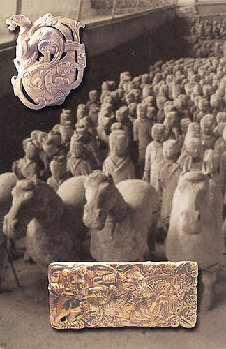Mausoleums of Princes of State ofChuin the Han Dynasty
Location:Xuzhou,JiangsuProvince
Period: 200BC-71AD
Excavated from 1981 to the present
Significance: It is of great importance to the study of the history and culture of State ofChu, as well as systems of building mausoleums for princes and emperors in the Han Dynasty (206BC-220AD).
 Introduction
Introduction
Mausoleums of Prince of Chu from the early Western Han Dynasty (206BC-8AD) totaled 13 in number, scattering in Little Tortoise Mountain,EastCaveMountain,NorthCaveMountain,TuoLanMountainandLionMountain, etc. They are the best-preserved imperial tombs by far. Among the 13 tombs, the one hollowed out of a cliff of today'sLionMountaininJiangsuProvince, is the best representative.
|

|
| Jade pedant with the patterns of footless dragon and tiger: ornament (up, length 5.2 cm); Gold belt buckle: decoration for belt (bottom, length 13.4 cm, width 6.2 cm) |
In the December of 1994 to the March of 1995, archaeologists excavated the tomb of the Prince of Chu inLionMountain. Covering about 850 square meters, it is one of the largest tombs inChinaand could tell us a lot of the ancient Chinese culture.
Although the tomb had suffered many incidences of looting, the objects recovered from it are fascinating. There nearly 2,000 precious relics found in it, including jade, gold and silver wares, bronze wares, weapons, seals, coins and pottery, many of which are the first discovery of this kind in China.
The master of the ancient tomb in Lion Mountain is Liu Wu, the third Chu prince, who was enfeoffed the Chu State (presently Xu Zhou) in early Western Han Dynasty. The terracotta warriors and horses found in 1984, which lies 300 meters to the west, is a part of the tomb, representing the guarding troops. There are 4,000 pottery figurines in total and were put in 6 pits. It tells us that in early Western Han Dynasty, the Chinese army still had chariot troops, mounted troops and foot soldiers, but the chariot unit was eliminated soon. So it is very important for the study of Chinese military history.
The luminous jadeZhi(wine container), cups, earrings and dragon-shaped ornaments reveal the luxurious lives of aristocrats, and the many official seals present evidence that the dukes of the early Han Dynasty were offered official posts and had armies for themselves. The most eye-catching objects from this tomb are four glittering gold buckles for the decoration of two belts, each 13.4 cm long and 6.2 cm wide, cast and chased with complex, elegant motifs, of two beasts eating a horse, surrounded by eight round-eyed, pointed-eared birds. Such motifs hint at the influence of pastoral culture.
